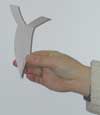|
||||||||||||||||
%
responses 2008 ('04) |
||||||||||||||||
y4 |
y8 |
|||||||||||||||
| 1. How could you make the whirligigs so lots of children would want to buy them? | ||||||||||||||||
| Mentioned ideas about: |
the general design (e.g. size, shape, structural features) |
38 (45) |
52 (42) |
|||||||||||||
the materials used |
40 (41) |
58 (52) |
||||||||||||||
decorative features
(e.g. colour, printed designs) |
93 (95) |
99 (95) |
||||||||||||||
the performance capabilities of
the whirligigs |
17 (22) |
32 (22) |
||||||||||||||
the packaging of the whirligigs |
11 (9) |
8 (7) |
||||||||||||||
the cost of the whirligigs |
41 (35) |
38 (43) |
||||||||||||||
| Overall merit of the responses: |
high |
0 (0) |
4 (0) |
|||||||||||||
quite high |
12 (7) |
16 (14) |
||||||||||||||
moderate |
35 (48) |
42 (43) |
||||||||||||||
low |
53 (45) |
38 (43) |
||||||||||||||
| 2. What problems might your team have when trying to make lots of whirligigs for the school fair? 3. What could your team do to overcome some of these problems? |
||||||||||||||||
| Mentioned ideas about: |
availability of suitable personnel |
53 (52) |
59 (62) |
|||||||||||||
processes and/or equipment |
47 (57) |
61 (35) |
||||||||||||||
supply/storage of materials |
54 (71) |
69 (60) |
||||||||||||||
coordination of personnel, resources
and processes |
61 (53) |
68 (67) |
||||||||||||||
| Overall merit of the responses: |
high |
0 (0) |
3 (3) |
|||||||||||||
quite high |
12 (19) |
22 (7) |
||||||||||||||
moderate |
39 (47) |
51 (38) |
||||||||||||||
low |
49 (35) |
25 (52) |
||||||||||||||
| 4. What else could your team do so that there are lots of whirligigs to sell? [e.g. order, production line.] |
||||||||||||||||
| Overall merit of the responses: |
high |
1 (2) |
3 (2) |
|||||||||||||
quite high |
16 (19) |
21 (7) |
||||||||||||||
moderate |
35 (41) |
43 (33) |
||||||||||||||
low |
48 (39) |
33 (58) |
||||||||||||||
Total
score: |
4–9 |
32 (22) |
32 (14) |
|||||||||||||
3 |
18 (24) |
22 (14) |
||||||||||||||
2 |
13 (17) |
16 (25) |
||||||||||||||
1 |
15 (19) |
14 (19) |
||||||||||||||
0 |
22 (19) |
16 (28) |
||||||||||||||
| Commentary: |
| Students had difficulty in discussing how to make paper whirligigs so that lots of students in their schools would want to buy them. This may have been attributable to the fact that the whirligigs were fairly simple to make, and students may not have seen them as something of value to purchase. Scores at year 4 and at year 8 were quite similar, but there is strong growth from 2004 to 2008.
|
